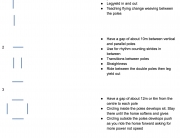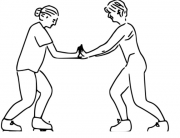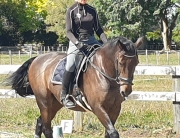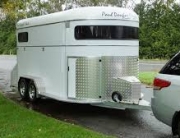Some Tips on how to deal with your fear
Give your fear a name. Lets call ours Nancy
Tell your fear to” Go Away Nancy” take control and stop the hormones that turn you into a quivering wreck (you can shout out loud or in your head — either works!)
One of my riders locks Nancy in her car when she comes for a lesson. Nancy is part of her life but my rider controls her.
Breathe
Calm your mind with focused breathing. You can use it before you ride, while you are riding and as soon as you recognize the first symptom of fear. Take long, slow, deep breaths Inhale through your nose, exhale through your mouth. Feel your belly expand on the inhale and collapse on the exhale. Changing your breathing is the fastest way to help you to feel more calm and confident. It helps your mind to slow down and relax. Try sighing as you breathe out.
Count your breaths and keep them slow. Try matching them to how slow you would like your horses footfalls. The slower you breathe the lower your heart rate will be.
Tension
Release tension from your body. Stiffness in your body affects your balance, suppleness and confidence. It also affects your horse. When you are nervous or fearful, you will have tension somewhere in your body. Is it in your shoulders and neck; your bottom or somewhere else?
Do a top-to-toe scan of your body to check for physical tension:
- Face and jaw are relaxed
- Shoulders away from ears
- Ribcage relaxed and not lifted and tense
- Engage your core
- Elbows heavy and hands soft
- Backside isn’t clenching
- Thighs heavy and lengthened downwards
- Lower leg relaxed
- Toes up
- Centre of gravity down
- Engage your lats –from (how do I sit balanced) section 1)
Visualization
Change the pictures you see in your mind. Visualization is a strong and proven technique used successfully by professional and world class amateur athletes to improve their skills and confidence. Your mind doesn’t know the difference between a real and an imagined event. If you keep replaying in your mind the mistakes you’ve made or situations that you imagine might happen, your mind believes you. Change your mental video tape from the possible catastrophic outcome to seeing the positive outcome you want. Your mind believes you either way. Use positive talk. “I can do this”
Focus your gaze on the area between your horse’s ears, not a ferocious stare but a soft, almost out-of-focus, supportive gaze so he knows you are just paying attention to him and not the ‘scary’ thing. You can do this out of the saddle too by finding a part of him to focus on rather than looking around you which will unsettle you both.
Count your hip swings; as the horse walks he will move your pelvis side to side, the more relaxed you are the easier it is for him to do so. Count to 10 and then start again. You can then use this hip swing to slow his gait too, slow your swing — he slows too. If you are on foot, just count your strides instead.
The Comfort Zone
Begin in your comfort zone. Ride where you are most comfortable and gradually move out of that area while paying attention to your breathing, your tension and your thoughts. When your stress increases to the point where you can’t manage your stress, go back to riding in your comfort zone until you are calm again.
Start small: if you are feeling anxious about hacking out try breaking it down into small, achievable steps:
Tack up, get on and get off again
Tack up, lead your horse on foot for a short distance then return home
Tack up, get on, walk a short distance with someone you trust on foot beside you
Walk a bit further with your ‘foot soldier’ for support
Train your Amygdala
There is a primitive part of your brain (the Amygdala). It is the center of your brain and is the area that triggers fear. It prepares your body for flight or fight which causes physical changes in your body like increased heart rate, shallow breathing and tense muscles.
In people and horses this area of the brain can be trained not to over react .
Repetition and positive experiences can help build new neural pathways around the Amygdala
Should I buy a vest?
Not only will it save you if you have a fall but it is a great confidence builder to know you are less likely to get hurt if you do fall off.
I recently took a rider for a lesson where she forgot to plug in her vest and proclaimed at the end of the lesson how much more confident she felt with it on only to find that she actually hadn’t had it properly on at all.
Learn a little horse language
Watch your horses ears If they are both well forward you do not have his attention
If they are flat back he is angry
Horses ears should flick forward and back one ear back means you have his attention
Have a look at
Anne Gage, Confident Horsemanship (www.annegage.com).
Jane Pike Joyride.com







Follow Us!